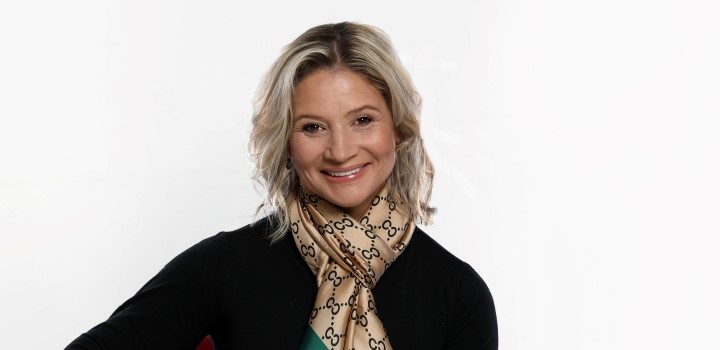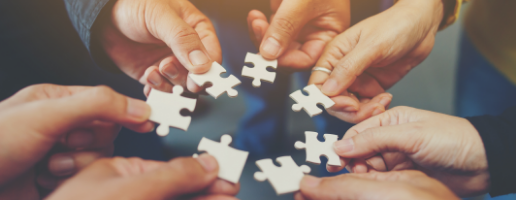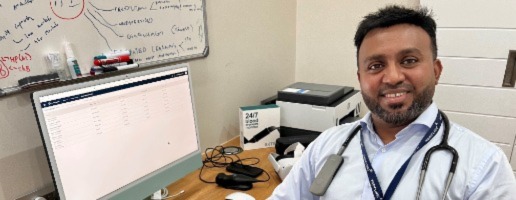Esther embraces technology to manage her unexpected diabetes diagnosis

Less than two years after being diagnosed with metastatic malignant melanoma - a cancer that spread through her lymph system - Esther de Jager (50) found out she had type 1 diabetes. Thanks to a top healthcare team and "incredible" technology, Esther's on top of her condition.
"In June 2019, I had just been declared in remission after a year of immunotherapy treatment for my cancer," recounts Esther. "My mom, my son and I were spending a month in the US as a victory trip. I still wasn't feeling well following the cancer treatment, but that didn't concern me. Then I started losing a lot of weight despite eating normally. And I got other strange symptoms like skin rashes and itchy, burning feet."
Soon after getting back to South Africa, Esther was extremely tired. One night, after vomiting profusely, she phoned her oncologist. "My oncologist had me admitted to hospital for what she suspected was severe dehydration. By the time I got to the hospital I was confused and couldn't speak properly. As nurses pushed me in a wheelchair to a ward, I went into a coma."
"When I woke up from the coma three days later, I'd been diagnosed as having type 1 diabetes."
"I was angry and depressed"
"It is rare for an adult to be diagnosed with type 1 diabetes. Unfortunately, in my case, the diabetes was a very rare side-effect of the immunotherapy I'd had to treat my cancer."
"My diabetes diagnosis came as an incredible shock. I had just come through a cancer journey, and now this. It was very traumatic. I went through a very difficult time and was angry and depressed. And I'd thought I knew a lot about diabetes, but until I started living with it, I realised I knew absolutely nothing."
"What helped me tremendously was the care I received from healthcare professionals and also some absolutely incredible healthcare technology that I was fortunate to get access to in time."
"This technology makes my life so much easier"
"To begin with, I was pricking my fingers to test my blood glucose (sugar) levels and manually injecting insulin medicine. My fingers became so bruised and calloused. I hated it."
"In February 2020, my doctor recommended I get a continuous glucose monitor (CGM) to monitor my blood sugar levels. It was such a huge relief that I didn't have to fingerprick all the time. It also gave me far more visibility of my condition, and so I was then able to manage it better."
"In July 2020, a year after my diagnosis, I got an insulin pump. The CGM takes my blood sugar reading every five minutes and automatically sends that information to the insulin pump. I can also see the readings on the pump's screen, on an app on my phone, and even on my Apple Watch. The pump uses an algorithm to process the information and administers the correct doses of insulin in the background, even when I'm sleeping."
"Each time I have a meal, I must input the amount of carbohydrates I'll be eating into the pump. The pump then calculates by itself how much insulin to inject to prevent my blood sugar levels from going too high."
"This technology makes my life so much easier."
"My pancreas now sits on the outside, not the inside!"
"Before I got the insulin pump, I was warned that it would be attached to me 24/7. I thought that might be hard for me."
"But I happened to get the pump in the middle of 2020's COVID-19 lockdowns. So I was working from home and was able to adapt, and having it on me didn't bother me at all. I mostly wore jeans or tracksuit pants and would just clip the pump onto the waistband."
"When I first started going out again, I was initially self-conscious of wearing an insulin pump. But that didn't last for long because the pump is part of me. My pancreas now just sits on the outside and not on the inside, and it helps to keep me alive."
"I was single when I was diagnosed, and I didn't think anyone would want to date someone with diabetes who has a pump attached to her all the time. But now I have the most amazing boyfriend, and he loves my pump more than I do. He knows how to read the pump, and it gives him comfort to know what's happening with me. He's even named the pump Suzie!"
Esther has also experimented with different ways to wear her pump depending on what she's wearing. If I wear a tight dress, I clip it onto the front of my bra, and when I wear a flowy dress, I put the pump in a special strap around my thigh."
"And I've found a company that makes a range of stickers with cute designs on them, which I sometimes use to cover the CGM on my arm. When it was Easter, I bought stickers with Easter eggs on them. And for Christmas, I bought reindeer stickers. So I try to have fun with it."
The DHMS Diabetic Care Programme supports Esther
"I am grateful for the Diabetes Care Programme offered by Discovery Health Medical Scheme. It paid for my insulin pump and for a large percentage of my CGM. The programme not only offers preferential rates on the insulin pumps and consumables that I need but it also offers a full care package. The Scheme pays for me to see my GP twice a year to do all the necessary blood tests and a diabetes nurse four times a year. It also covers one appointment per year with an ophthalmologist, podiatrist, dietitian and biokineticist to deal with all of the potential complications of diabetes and how they affect the body as a whole."
- Scheme members registered for type 1 diabetes on the Chronic Illness Benefit have cover for continuous glucose monitoring (CGM) according to their health plan's benefits.
"Everything changed"
Esther talks about the lifestyle changes she had to make after her diabetes diagnosis. "Everything changed," she says. "You will never think about food the same way if you've been diagnosed with diabetes and you have to unlearn many things. For instance, I always thought that fruit was good for me, but now I don't touch fruit at all because of its high sugar levels. I have not only had to learn about how carbohydrates affect my blood sugar levels but also how the other food groups affect me."
"I keep jelly babies in my car, office, and next to my bed in case my blood sugar levels drop too low."
Esther's GP, diabetic nurse, and dietitian were all instrumental in helping her with the information she needed for her new diet. "I also found a Facebook group for people who use the same insulin pump that I do. I've learned so many tips and tricks from other people with this condition, and it also acts as a fantastic support group."
CGM gives Esther the confidence to exercise
"For a long time after my diagnosis, I was too scared to do any exercise because I wasn't sure how my body would react. When a person who has diabetes exercises, blood sugar can drop severely, so I had a mental block here."
"It has only been since about the middle of 2022 that I've been exercising again. I don't know how I would've done it if I didn't have the CGM and pump. Now I always know what is happening with my blood sugar levels at a glance, in an instant, and that has really given me the comfort and confidence I needed to continue exercising."
"Now I walk my dogs every day and sometimes play tennis. I also enjoy other outdoor activities like hiking."
"It's not the end of your life"
"In terms of mental health, I was OK when I was going through my cancer journey. But when I was diagnosed with diabetes right after that, I completely collapsed. I was very depressed. I eventually went to see a psychiatrist, who prescribed an anti-depressant. I also started seeing a psychologist. The combination of the two was very necessary and has been very helpful."
"I want other people with diabetes to know that having this condition does not mean the end of your life. Make use of the resources at your disposal, like the ones that DHMS offers. Don't go through it all alone, especially if you're newly diagnosed. It's a complicated condition, and you need all the support you can get."
Discovery Health Medical Scheme is an independent non-profit entity governed by the Medical Schemes Act, and regulated by the Council for Medical Schemes. It is administered by a separate company, Discovery Health (Pty) Ltd, an authorised financial services provider.
Related articles

Your Diabetes Care team gives you the support you need to manage your diabetes
If you have diabetes, you know how important it is to manage the condition well. You need support to do this. Being surrounded by the right healthcare team makes diabetes management and care far simpler for you and far more effective overall - ensuring your best quality of life.

Reona recovers in the comfort of home with Hospital at Home
For Reona Naidoo, the Hospital at Home programme has made getting sick regularly (post a surgery in 2019) more bearable. She now has access to 24/7 treatment and monitoring, giving her peace of mind about her health - and also about avoiding separation from her two children for days on end.

Dr Govender uses 'brilliant' Hospital at Home to treat patients in the comfort of their home
As an early adopter of the Discovery Hospital at Home programme, Dr Sudeshan Govender reports back on the significant benefits for his patients - including access to cutting-edge remote monitoring technologies and top healthcare teams, and more.